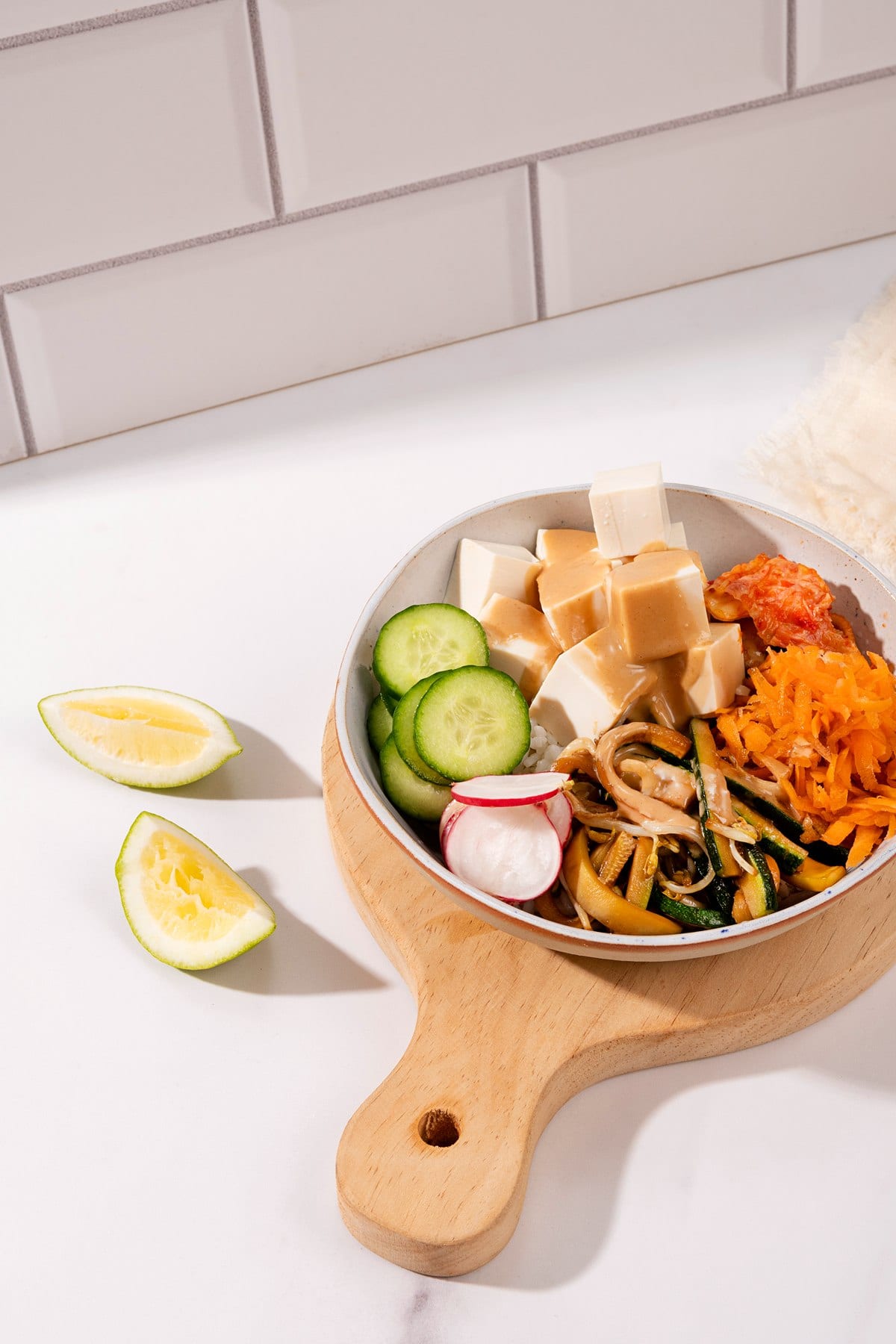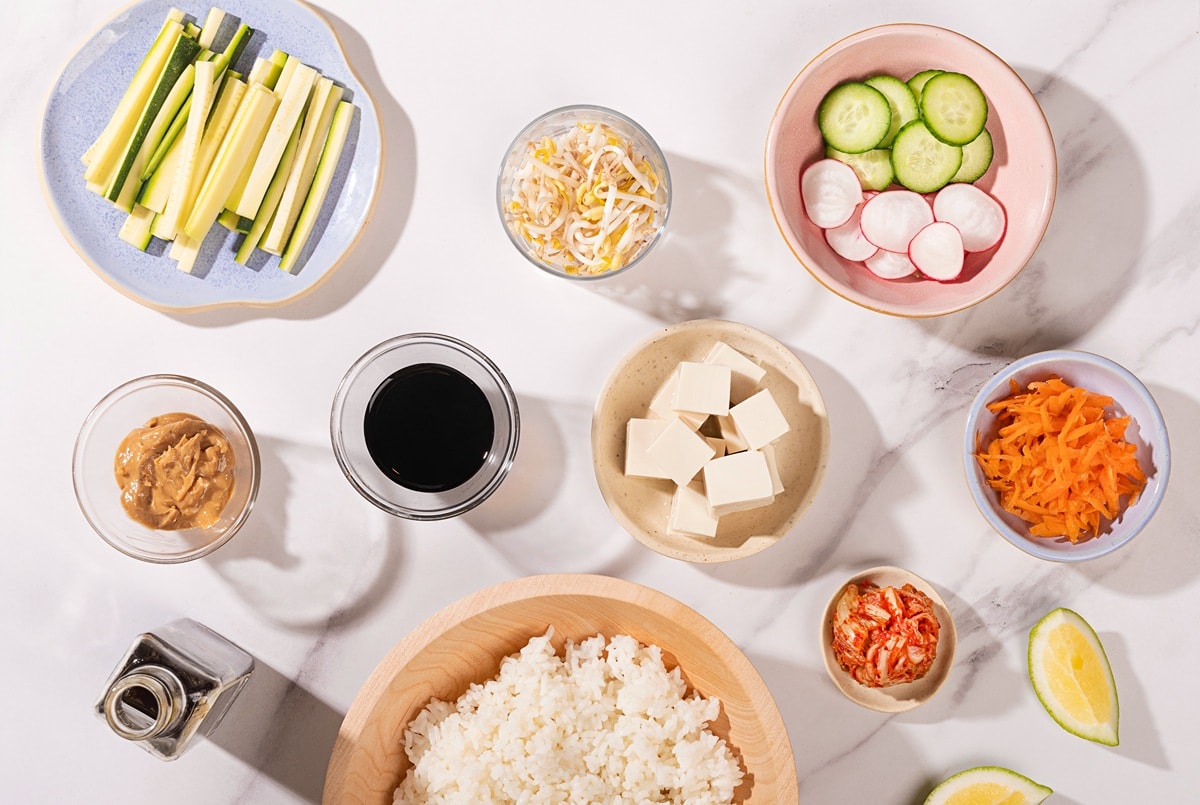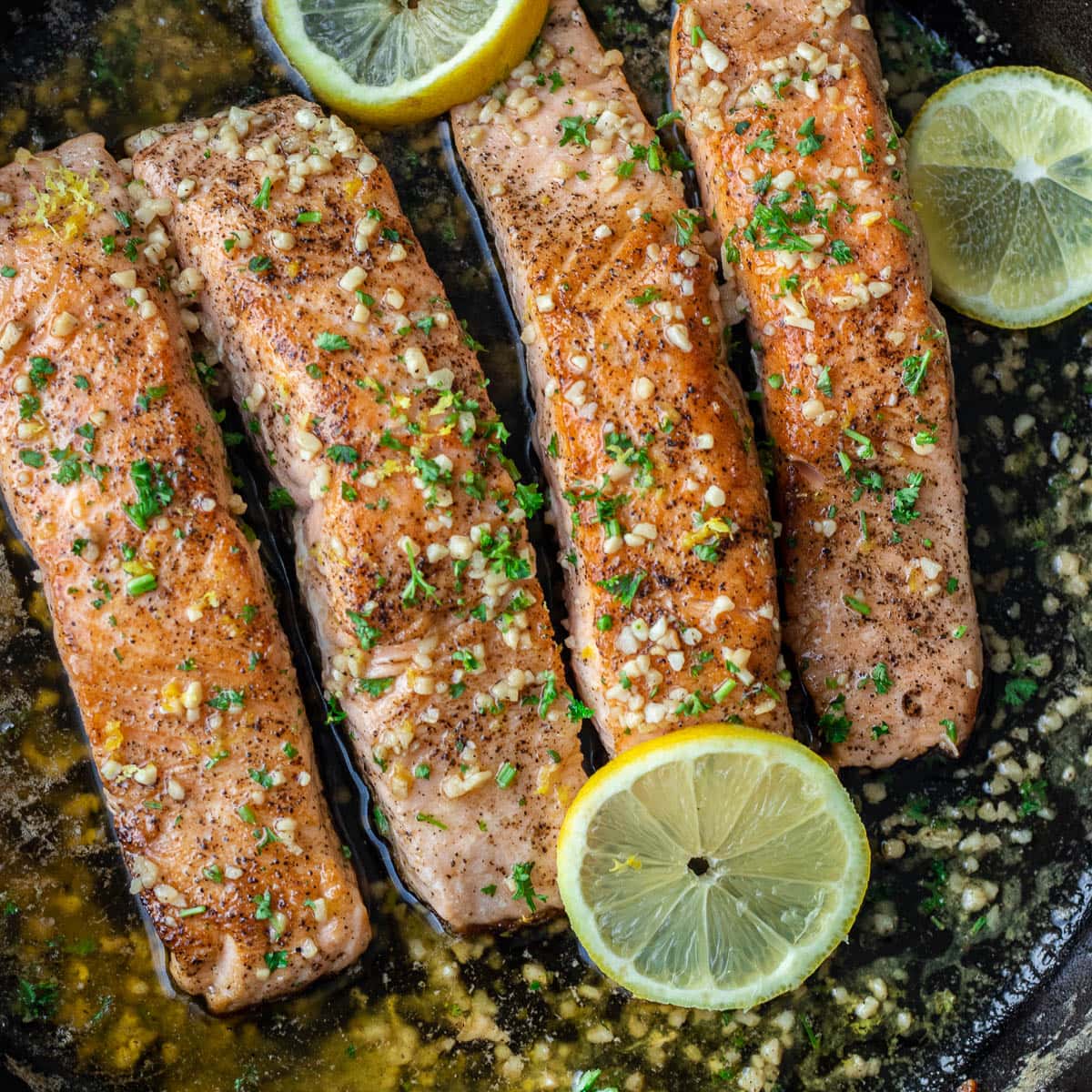Korean Vegan Bibimbap Bowl (High-Protein Recipe!)
HurryTheFoodUp is reader-powered. If you click through using links on our site we may earn a small commission at no cost to you.
If you loved last week’s vegetarian bibimbap blog post but weren’t keen on the eggs take a look at the new peanutty vegan bibimbap!
As far as vegan Korean recipes go this popular Korean rice bowl will make your taste buds smile.
Layers of rice, crunchy veg, and tofu are all enrobed in a gorgeous peanut butter sauce. I’m sure you’re going to love this bibimbap recipe as much as I do!

Ingredients
Rice
Did you know? Bibimbap is the Korean word for ‘mixed rice’. I chose sushi rice, which is short grain rice. I think it works best for this recipe as it has a sticky consistency, making it a great base for the other ingredients.
Veggies
I’ve chosen a slightly different assortment of vegetables for the vegan version of bibimbap. Zucchini, cucumber, carrot, and mung bean sprouts still all feature.
But I’ve also added a lovely peppery kick from the radish to this recipe.
I also decided to keep the kimchi as an optional topping. If it’s your first time using it and you don’t know, kimchi is a blend of vegetables, mostly cabbage, that have been fermented.
It’s the national food of Korea so it’s used a lot in Korean cooking.
Tofu
Protein is coming from tofu. It’s really easy to find in your local grocery stores and it’s a great ingredient as it can take on lots of different flavors depending on what you add to the dish.
A secondary source of protein in this Korean bibimbap is coming from the peanut butter used in the sauce.
Sauce
This is probably my favorite of all the bibimbap toppings. Peanut butter sauce is so easy to make.
Traditionally this dish usually comes with a gochujang sauce which is thick, sweet, and spicy and made with fermented chili peppers. So I’ve altered this one quite a bit.
However, if you want a more traditional version our vegetarian recipe may be what you’re looking for.
I just added peanut butter, sugar, soy sauce, sesame oil, and water to a small bowl and mixed it all up. If it’s a little thick you can add more water than I did if you like.
There are lots of different ways to make a bibimbap sauce but there is definitely something special about this one. I love its nutty flavor and the way it envelopes the tofu and veggies – delish!

How many calories are in bibimbap?
kcal 522kcal
Carbs 62g
Fat 21g
Protein 25g
Health Benefits
There are loads of nutrients coming at you from this classic Korean dish. Those fresh vegetables are loaded with vitamins, especially carrots and zucchini which are rich sources of Vitamin A.
The cucumber has a high water volume, which is great for your hydration levels and its skin is full of fiber.
Some of the health benefits of radishes include regulating blood sugar and lowering blood pressure (no wonder Mr. McGregor was so keen to hang on to his!)
Tofu and peanut butter are great sources of protein as I mentioned earlier. In fact, peanut butter has 8 grams of protein per 2 tablespoons as well as a great level of fiber.
Protein and fiber are going to do wonders to keep you feeling full in between meals. It’s also a great tool for helping to build lean muscle in a healthy way.
If this is the journey you’re on have you downloaded your FREE 7-day High-Protein Meal Plan yet?
And if that’s still not enough inspiration you might like to move on to the weekly plans so you have new recipes for every day of the week!

How to make my easy vegan bibimbap recipe
Here’s a quick run-through of how to make this dish,
- Prep work: Cook the rice to get started, it needs the time so it’s not too hard – nothing worse than undercooked rice! Cube the tofu, grate the carrot, slice the cucumber and radishes and cut the zucchini into sticks.
- Sauce work: In a small bowl mix the peanut butter, sesame oil, cold water, soy sauce, and sugar.
- Cook work: Fry off the zucchini and bean sprouts until tender.
- Assemble work: Take your cooked bowl of rice and add the toppings. Add the kimchi and another tablespoon of soy sauce if you fancy.
- To finish: If you want you can serve with lemon wedges which compliment the other flavors nicely.
Vegan Bibimbap FAQs
Is a bibimbap healthy?
Yes, I would say bibimbap is really healthy. It has a great combination of food groups.
Which includes carbohydrates from the fluffy rice, loads of nutritious vegetables, great sources of protein, and healthy fats from the peanut butter sauce.
What more could you want?
Does bibimbap come with rice?
Yes, in this classic bibimbap, rice is the base ingredient. If you don’t like rice, perhaps you could try noodles instead.
Is bibimbap good for weight loss?
Yes, these bibimbap ingredients would certainly aid in a weight loss journey as part of a calorie-controlled diet.
The protein from the tofu and peanut butter would keep you feeling fuller for longer, a key tool to successful weight loss.
If you want some more meal ideas to help you on your weight loss journey have a look at my collection of 60 vegan weight-loss recipes for loads more inspiration.
Or if you’re finding your weight loss has plateaued take a look at this article, it’s full of tips to help you get back on track.
Can you eat bibimbap cold?
You can eat bibimbap hot or cold. By cold, I mean room temperature.
In Korea, they tend to eat it hot in the winter. The winter version is traditionally called dolsot bibimbap.

Variations and Alternatives
If you wanted to change up the vegetables in this dish, next time, why not try shiitake mushrooms, bok choi or spring onions instead to keep up that authentic Korean flavor?
You could also try different sauces if you’re allergic to peanuts. In Korean cuisine they use a couple of sources specifically on their bibimbaps including a spicy gochujang sauce.
For a little bit extra you could even sprinkle sesame seeds on top. A bibimbap is a great way to get creative in the kitchen !
More Veggie Bowl Recipes
If you love this recipe, I think you’ll enjoy these too!
Top Tips
If you have a little extra time in your week, this would be a great dish to meal prep. You could get all the rice, veg and tofu packed into airtight containers.
Keep your sauce in a separate container and then it can be drizzled on when you’re ready to eat it.

A beautiful bowl of crunchy veg, tofu, drizzled with a peanut butter glaze? This vegan Korean bibimbap bowl is amazing!
- ½ cup sushi rice
- 3 tsp sesame oil (divided)
- 9 oz tofu
- 1 carrot (small, 60g)
- 1 cucumber (small, 85g)
- 2 radishes
- 1 zucchini (small, 180g)
- 2 tbsp peanut butter
- 2 tsp sugar
- 3 tbsp soy sauce (divided)
- 1 cup bean sprouts
- ¼ cup kimchi (optional)
- Lemon wedges
-
Cook sushi rice according to package instructions. Once it’s ready, add 2 tsp of sesame oil and mix.
½ cup sushi rice, 3 tsp sesame oil
-
Cut tofu into 2 cm/1 inch cubes.
9 oz tofu
-
Grate the carrot.
1 carrot
-
Cut cucumber into slices.
1 cucumber
-
Cut radish into slices.
2 radishes
-
Cut the zucchini into sticks.
1 zucchini
-
In a small bowl add peanut butter, sugar, ½ tsp sesame oil, 6 tbsp water and 1 ½ tbsp soy sauce. Mix until combined. Add salt to taste. If necessary, add extra water.
3 tsp sesame oil, 2 tbsp peanut butter, 2 tsp sugar, 3 tbsp soy sauce
-
In a small non-stick pan add ½ tsp of sesame oil and the zucchini sticks. Cook until they soften, about 1-2 minutes. Add the bean sprouts, 1 tbsp of soy sauce, plus a pinch of salt. Cook until the bean sprouts are tender and translucent, about 1 minute.
1 cup bean sprouts
-
To serve, add rice to a bowl and top with tofu, carrot, cucumber, radish, zucchini with bean sprouts and kimchi. Drizzle remaining 1 tbsp soy sauce to season (½ tbsp per serving). Serve with peanut sauce and lemon wedges if using.
¼ cup kimchi, Lemon wedges
Nutrition Facts
Vegan Korean Bibimbap Bowl (High-Protein Recipe!)
Amount per Serving
% Daily Value*
* Percent Daily Values are based on a 2000 calorie diet.
I hope you have fun making your Korean bibimbap. Vegan bibimbap bowls are a big hit in our house, and I’m sure they’ll soon be a hit in your house too.
For more ideas check out these vegan dinner recipes there are 102 of them – that’s enough for the next 14 weeks!




